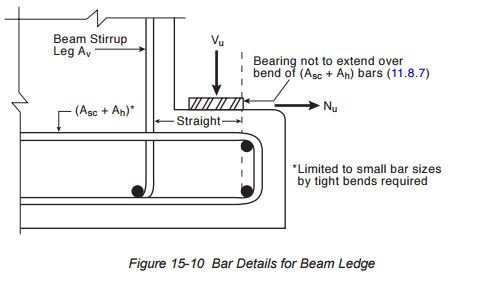perfectaccess
Structural
- Oct 29, 2015
- 62
Hi
ACI318-2011
11.8.6 — At front face of bracket or corbel, primary
tension reinforcement shall be anchored by one of the
following:
(a) By a structural weld to a transverse bar of at least
equal size; weld to be designed to develop fy of
primary tension reinforcement;
(b) By bending primary tension reinforcement back
to form a horizontal loop; or
(c) By some other means of positive anchorage.
Can anyone explain a,b options by sketch pls
Bearing area on bracket or corbel shall not
project beyond straight portion of primary tension
reinforcement, nor project beyond interior face of
transverse anchor bar (if one is provided).
What I can get from this,that the bearing area should not lies on the concrete cover,while the second part is saying for vertical reinforcement stirrup if exist(the bearing area should not lie outside the vertical reinforcement-->cover area as well)
11.8.3.2 — Design of shear-friction reinforcement,
Avf , to resist Vu shall be in accordance with 11.6.
+Where is the statement in the code deal with direct shear, the code is Tilling to provide as per section 11.6,which I dont understand ,how on the earth parallel stirrups may resist shear,does not make scene?
Where shear-friction reinforcement is
inclined to the shear plane, such that the shear force
produces tension in shear-friction reinforcement, Vn
shall be computed by
Vn = Avf fy (μ sin α + cosα) (11-26)
where α is angle between shear-friction reinforcement
and shear plane.
Finally what is characteristic of this plate bearing,it should be steel,or can i put some high strength plastic material as precast people do,and why use this plate and lieing the whole load on the whole area?
ACI318-2011
11.8.6 — At front face of bracket or corbel, primary
tension reinforcement shall be anchored by one of the
following:
(a) By a structural weld to a transverse bar of at least
equal size; weld to be designed to develop fy of
primary tension reinforcement;
(b) By bending primary tension reinforcement back
to form a horizontal loop; or
(c) By some other means of positive anchorage.
Can anyone explain a,b options by sketch pls
Bearing area on bracket or corbel shall not
project beyond straight portion of primary tension
reinforcement, nor project beyond interior face of
transverse anchor bar (if one is provided).
What I can get from this,that the bearing area should not lies on the concrete cover,while the second part is saying for vertical reinforcement stirrup if exist(the bearing area should not lie outside the vertical reinforcement-->cover area as well)
11.8.3.2 — Design of shear-friction reinforcement,
Avf , to resist Vu shall be in accordance with 11.6.
+Where is the statement in the code deal with direct shear, the code is Tilling to provide as per section 11.6,which I dont understand ,how on the earth parallel stirrups may resist shear,does not make scene?
Where shear-friction reinforcement is
inclined to the shear plane, such that the shear force
produces tension in shear-friction reinforcement, Vn
shall be computed by
Vn = Avf fy (μ sin α + cosα) (11-26)
where α is angle between shear-friction reinforcement
and shear plane.
Finally what is characteristic of this plate bearing,it should be steel,or can i put some high strength plastic material as precast people do,and why use this plate and lieing the whole load on the whole area?


